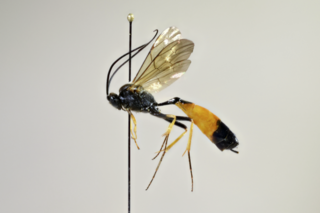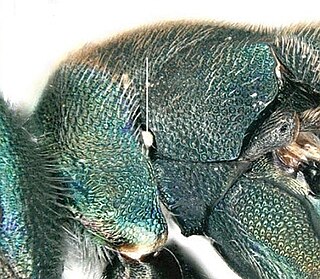
The Ichneumonidae, also known as ichneumon wasps, ichneumonid wasps, ichneumonids, or Darwin wasps, are a family of parasitoid wasps of the insect order Hymenoptera. They are one of the most diverse groups within the Hymenoptera with roughly 25,000 species described as of 2016. However, this likely represents less than a quarter of their true richness as reliable estimates are lacking, along with much of the most basic knowledge about their ecology, distribution, and evolution. It is estimated that there are more species in this family than there are species of birds and mammals combined. Ichneumonid wasps, with very few exceptions, attack the immature stages of holometabolous insects and spiders, eventually killing their hosts. They play an important role as regulators of insect populations, both in natural and semi-natural systems, making them promising agents for biological control.

This glossary of entomology describes terms used in the formal study of insect species by entomologists.

Megarhyssa, also known as giant ichneumonid wasps, giant ichneumons, or stump stabbers, is a genus of large ichneumon wasps, with some species known for having the longest ovipositors of any insects. They are idiobiont endoparasitoids of the larvae of wood-boring horntail wasps. The ovipositor can be mistaken for a large stinger. This is a genus of holometabolous insects within subfamily Rhyssinae that includes 37 species and belongs to Ichneumonidae, the family of wasps with the highest biodiversity in the world.
Diadegma auricellae is a wasp first described by Horstmann in 2008. No subspecies are listed.
Diadegma callisto is a wasp first described by Horstmann in 1993. No subspecies are listed.
Diadegma colutellae is a wasp first described by Horstmann in 2008. No subspecies are listed.
Cecinothofagus is a genus of wasps. Its name is derived from cecidium and Nothofagus, the name of the host plant genus. This genus differs from Paraulax by a median vertical carina that extends from the ventral margin of the clypeus, almost reaching the ventral margin of the antennal sockets; its facial strigae radiating from the lateral clypeus; the ventral part of its clypeus is straight; a lateral, sharp occipital carina is present; its last antennal flagellomere is 1.5 to 1.7 times longer than wide; longitudinal costulae running from the lateral margin of its pronotal plate to the lateral surface of its pronotum are very short or absent altogether; notauli are sinuate; no scutellar foveae are present; simple claws, sometimes carrying a short basal lobe.

Anomalon is a large genus of parasitoid wasps belonging to the family Ichneumonidae. This may be the only genus in the tribe Anomalonini, although Neogreeneia Viereck, 1912 is sometimes considered a valid genus of the tribe.

Pimpla rufipes, the black slip wasp, is a species of wasp belonging to the family Ichneumonidae. It is distributed across Europe, Asia, and northern Africa.

Dusona is a genus of parasitoid wasps belonging to the family Ichneumonidae. It is the most species rich genus of the subfamily Campopleginae with 442 known species.

Dusona falcator is a large species of parasitic wasp belonging to the family Ichneumonidae, subfamily Campopleginae. It is a parasitoid of the buff-tip moth. It is one of the largest known species of Camopleginae, able to reach sizes over 20mm. The species can be found throughout the Palearctic realm.
Dusona admontina is a species of parasitic wasp belonging to the family Ichneumonidae, subfamily Campopleginae. It is a parasitoid of the larvae of Herminia grisealis.
Dusona abdominator is a species of parasitic wasp belonging to the family Ichneumonidae, subfamily Campopleginae.
Dusona aemula is a species of parasitic wasp belonging to the family Ichneumonidae, subfamily Campopleginae. It is a parasitoid of Geometrid moth larvae, mainly Eupithecia species.
Dusona juvenilis is a species of parasitic wasp belonging to the family Ichneumonidae, subfamily Campopleginae. It is a parasitoid of Eupithecia haworthiata larvae.

Dusona leptogaster is a species of parasitic wasp belonging to the family Ichneumonidae, subfamily Campopleginae. It is a parasitoid of Geometrid moth larvae, the two known hosts being Alsophila aescularia and Lomaspilis marginata.
Dusona nidulator is a species of parasitic wasp belonging to the family Ichneumonidae, subfamily Campopleginae. It is a parasitoid, but the host is unknown.

Callidora is a genus of parasitoid wasps belonging to the family Ichneumonidae and the subfamily Campopleginae. It is relatively species poor, with only five recognized species.
Aiura is a genus of parasitoid wasps belonging to the family Ichneumonidae and the subfamily Campopleginae.

The superfamily Chalcidoidea is a megadiverse group of parasitic wasps that share these features:








